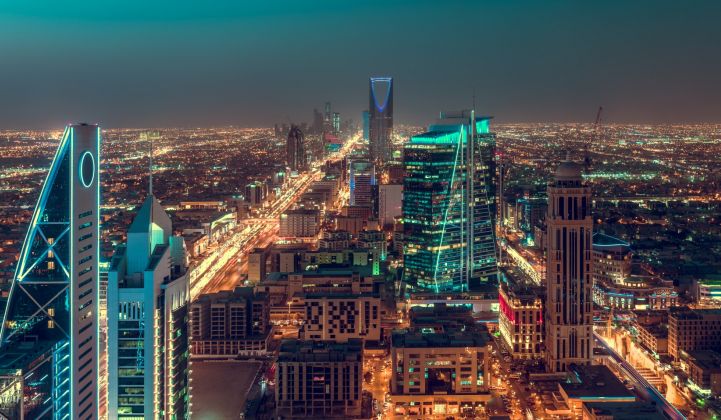Saudi Arabia and Japanese financial giant SoftBank have pledged to spend about $200 billion through 2030 to build 200 gigawatts of solar PV, a move that could upend the global solar landscape — if it comes to fruition.
But the memorandum of understanding released Wednesday contains few concrete details on how the partners will secure the massive amount of debt required. It also didn’t mention the challenges involved in scaling up logistics and manufacturing capacity in a country that had less than 50 megawatts of solar PV installed as of last year, less than Louisiana or Kyrgyzstan.
And it didn’t discuss how tripling Saudi Arabia’s total solar capacity would be integrated into the power grid and tariff structures, or possibly exported to other countries.
These uncertainties, along with unmet promises of grand solar growth in Saudi Arabia in the past, have led solar industry watchers to take the Saudi-SoftBank announcement with a healthy dose of caution.
“It’s an unprecedented construction effort; it’s an unprecedented financing effort,” said Benjamin Attia, a global solar analyst for GTM Research. “But there are so many questions, so few details, and a lot of headwinds, like grid instability, the availability of commercial debt, construction and logistics challenges."
Looking at Saudi Arabia’s current state of solar development, “We’re not wiling to buy into the hype until we see something happen on that initial 7.2 gigawatts,” he said.
Attia is referring to the 3.2-gigawatt and 4-gigawatt solar farms that will constitute Phase 1 of the grand plan. The two projects are on an extremely fast track, with interconnection expected by mid-2019, “which is aggressive,” he said.
They’re expected to cost about $5 billion, with about 80 percent from project financing. The initial equity investment of $1 billion is coming from SoftBank's $100 billion Vision Fund, which counts Saudi Arabia's Public Investment Fund as its largest investor, with $45 billion invested.
The $5 billion for 200 megawatts “seems a little low for total cost,” Attia noted.
Saudi Arabia caught headlines in October when it announced prices of under 2 cents per kilowatt-hour for a 300-megawatt tender, shattering world records. But as Attia noted at the time, those low prices were likely made possible through some form of direct or indirect subsidy within the power-purchase agreements, since they couldn’t otherwise be profitable. Saudi Arabia’s government has been the primary driver of these solar projects through its Renewable Energy Project Development Office (REPDO).
In January, REPDO announced another tender for about 3.3 gigawatts of solar and 800 megawatts of wind power. But “there are already a lot of questions about the REPDO program, with prices starting so low” based on expectations from the October tender, Attia said.
In fact, the Phase 1 projects announced Wednesday could lead to increased uncertainty among solar investors. "If you think you could take higher returns with this SoftBank deal, this could lead to restraint from participants the upcoming REPDO tenders," said Attia.
SoftBank Vision Fund's pledge of $1 billion in equity investment for the Phase 1 project indicates that it's planning to take up to a 20 percent stake in future projects, leaving 80 percent of project costs to be covered by debt financing. But the sheer size of the plan will require a staggering amount of commercial debt, noted Attia.
“Meeting the stated 10 to 20 percent equity threshold, especially with reinvested returns from earlier stages of the project, is probably feasible, but the availability of such a massive volume of commercial debt remains in question,” he wrote in a GTM Research note. Saudi Arabia’s strict requirements for domestic manufacturing could also raise costs and hurt the bankability of the projects, he observed.
Saudi Arabia has projected that the SoftBank-funded projects will turn the kingdom into a solar manufacturing center, create 100,000 jobs, increase gross domestic product by $12 billion, and save $40 billion by cutting back on oil-fired electricity generation.
But Saudi Arabia and SoftBank have a history of making grand announcements that haven't panned out. In 2012, Saudi Arabia announced plans to build more than 40 gigawatts of solar PV and concentrating solar thermal power plants by 2032. However, the plan saw no action from the government, and was scaled back to 9 gigawatts in its “Vision 2030” plan released last year.
In 2015 SoftBank announced a plan to invest $20 billion in the Indian solar market with Foxconn and Bharti Enterprises. GTM Research's Global Solar Data Hub shows less than 800 megawatts of operational and pipeline projects developed by SB Energy to date.
There’s also the long-term question of just what Saudi Arabia will do with so much solar power. The country currently gets the vast majority of its 77 gigawatts of generation capacity from oil and natural gas.
While the country has a large air conditioning-driven peak load and is seeing rapid growth in consumer energy demand, it’s still unlikely to need three times that much energy throughout the mid-morning to mid-afternoon hours when solar PV reaches maximum output.
Simply put, "Without lots and lots of long-duration batteries, they’ll either be curtailing the solar generation or exporting it to other countries,” Attia said. Wednesday’s announcement did mention a large-scale battery storage rollout, but no specific details were given.




